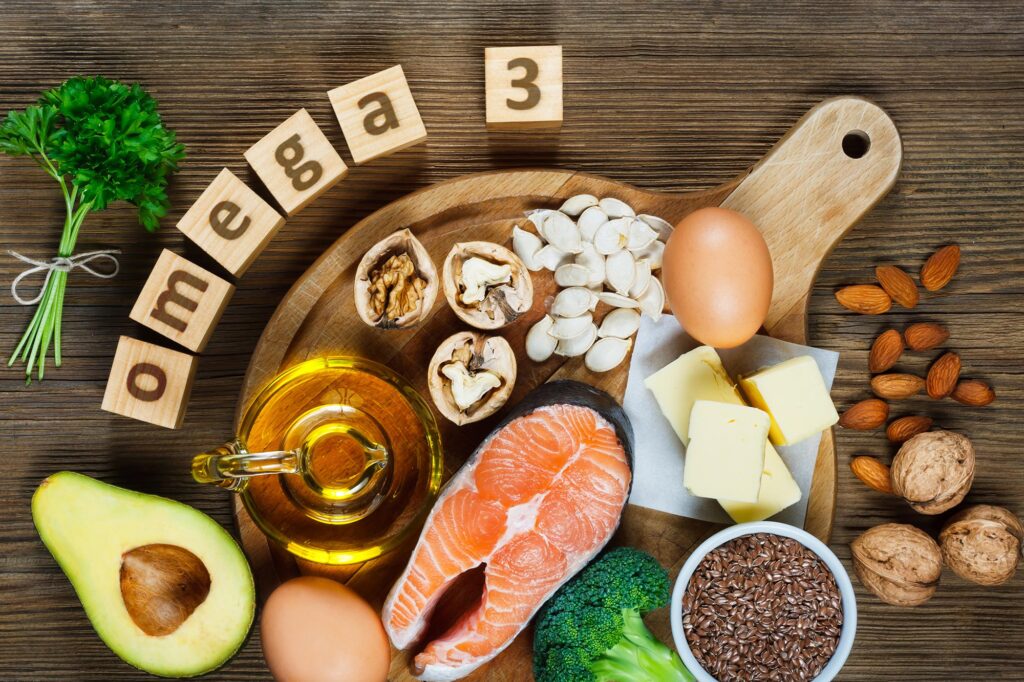
Omega-3 fatty acids are one of the numerous cases that have been recognized, commonly referred to as missing. Although leafy greens and other plant foods also contain omega-3s, seafood is the dietary source where they are most frequently encountered. Algae-3 is likely the largest supplier of fatty acids, with fish being the first. There are three basic types of omega-3 fatty acids:
- alpha-linolenic acid (ALA);
- eicosapentaenoic acid (EPA);
- docosahexaenoic acid (DHA).
Omega-3 fatty acids are vital to cells and support their efficient functionality. Essential for both physical and mental health are omega-3 fatty acids. Additionally, they contribute to the formation of eicosanoids, crucial components in the:
- Cardiovascular system: This includes the heart, blood vessels, and blood.
- Pulmonary system: This is the lungs, airways, and blood vessels;
- Immune system: This consists of the bone marrow, spleen, lymphatic system, and white blood cells;
- Endocrine system: This contains the pancreas, adrenal glands, thyroid gland, pituitary gland, and hormones.
The scientists also state that increasing omega-3 intake may help people with neurological diseases like Alzheimer’s.
Foods High in Omega-3
Many public health organizations recommend at least 250–500 mg of omega-3s per day for healthy adults. Here is a list of 20 very high omega-3 vegetables and seeds:
- Mustard seeds (239 mg per tablespoon, ground);
- Flax seeds (2350 mg per serving);
- Chia seeds (5060 mg per serving);
- Hemp seeds (1000 mg per 1 tablespoon)
- Walnuts (2570 mg per serving);
- Soybeans (1241 mg per serving);
- Natto (642 mg per ½ cup);
- Spinach (166 mg per 1 cup cooked, 41 mg per 1 cup raw);
- Butternut squash (332 mg per 1 cup of pulp);
- Avocado (100 g of avocado for omega-3 will have 0.147 g);
- Broccoli (300g contains 400mg of omega-3s);
- Walnuts (100g contains 9.08g of omega-3s);
- Beans (boiled contains 0.62 g of fat per 100 g of product);
- Purslane (300 mg per ½ cup);
- Rapeseed oil (1279 mg per 1 tablespoon);
- Flaxseed oil (7.258 mg per tablespoon);
- Soybean oil (18 to 20 percent omega-3s);
- Brussels sprouts (88 milligrams omega-3s);
- Seaweed and algae;
- Edamame (half a cup contains 0.28 grams).
Healthy Diet with Omega-3. Seeds
Flax seeds are indeed high in omega-3 fats, with about 50% omega-3 fats and 10% omega-6 fats, while sunflower and sesame seeds, pumpkin seeds, and sesame oil are all significant sources of omega-3 fats. If you only consume one scoop for breakfast, you can make up the difference by adding cold-pressed vegetable oil to your salad or by adding a few nuts or seeds to your diet. Growing chia seeds can be a rewarding and exciting activity for you. Chia is not a fickle plant. The area prefers sunny, dry weather, preferably without standing water. From August to September, seeds mature. They are attractive and resemble tiny decorative beans. Seeds of chia are oval, smooth, shiny, white, gray, or brown, and they also have a pattern on their surface. By sprouting, you get salad sprouts, and by grinding them into flour, you get a nutrient-rich baking ingredient. As a topping, they provide a crunchy flavor to soups, salads or desserts and are a considerable substitute for bread and biscuits. Therefore, try to grow, use and enjoy healthy products filled with Omega-3!
Great source of heirloom seeds
One independent and small-business that sells heirloom seeds online is the Ethos Seed Company (https://ethosseed.com/) – you can purchase seeds on their website.
They sell heirloom vegetable seeds, herb seeds and flower seeds. The website also provides very useful tips and information about gardening and growing vegetables.
This small business is woman-owned which is a great thing to encourage as well.
It has a diverse selection of seeds with the “staple” selections that include the following categories: kale, tomatoes, peppers, lettuce, beans, carrots, squash, cucumbers and many more!
Once you have ordered the seeds that you would like to plant, get ready to start a beautiful garden, and prepare for the right planting season. If you are not sure what to do, you can always connect with your seed provider who would be thrilled to help.



